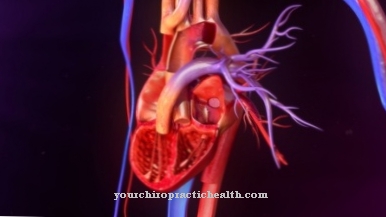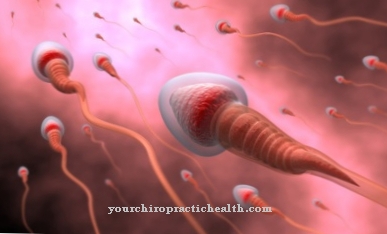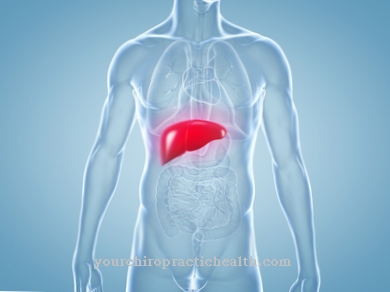The Swing leg phase is one of the main components of the gait pattern. The range of motion can be considerably restricted by functional restrictions in the sequence of movements.
What is the swing leg phase?

The swing leg phase describes the sequence of movements of the free leg when walking and running. Together with a standing leg phase, this results in a gait cycle.
The swing leg phase can be analytically and functionally divided into 3 sections, the early, the middle and the terminal swing phase. It begins with lifting the leg after the standing leg phase. The thigh is raised by the hip flexors and the lower leg by the knee flexors, the foot initially remains passive.
In the middle phase, the leg is moved forward by increased hip flexion, while the knee is loosely vertical. Toes and feet are actively raised so that they can be brought forward above the ground. In this phase the flexion in the hip joint reaches its greatest extent.
In the terminal standing leg phase, the leg is lowered again towards the floor. At the same time, the knee is actively stretched and the foot is kept in a neutral position, in preparation for the upcoming ground contact with the heel. A functionally important accompanying component is the forward rotation of the pelvis.
Function & task
The swing leg phase is important for gaining space when walking. While the entire body moves forward on the standing leg side, the simultaneous transport of the free leg on the swing leg side ensures that the next step can be continued while gaining distance.
At normal walking pace, the movement components of the swing leg phase are designed in such a way that a fluid gait pattern is created with minimal effort. The hip flexion is relatively small in all phases and the foot is only lifted a few centimeters from the ground. Only the knee joint is relatively strongly flexed in the first phase, but only for a short time.
The main work for the forward movement is done by the hip flexors, while the knee flexors at the beginning and the extensors of the ankle and toes in the middle show holding work or braking muscle activity. In the terminal swing leg phase, the knee extensors are then active and the hip flexors control the adequate lowering of the leg.
An increase in the speed of movement leads to an accentuation of all movement components. This can be seen very clearly with sprinters. Above all, the hip flexion achieves much higher degrees of movement than with normal walking and the foot is pulled up significantly from the start.
Overcoming heights also requires more flexion in the hip joint and greater extension in the foot and toe, while walking on a sloping road reduces both components. The amplitudes of movement are also influenced by the step length, which in turn depends on the relative leg length. With small steps, the swing leg phase only lasts short, so there is little time for the implementation. For this reason, the range of motion in the hip and knee flexion in the early and middle phases is less than with normal stride length. Conversely, with long strides, the flexion in the hip joint in particular is increased. At the same walking pace, the step length also changes the step frequency. With short steps it is higher than with long ones.
You can find your medication here
➔ Medicines for balance disorders and dizzinessIllnesses & ailments
The muscles that are active in the swing leg phase have to exert enough force that the sequence of movements can be coordinated against gravity. All illnesses that lead to a reduction in strength, a complete loss of strength or coordination disorders impair the swing leg phase or completely prevent it from being carried out.
Herniated discs can lead to a lesion of the sciatic nerve, which supplies the foot lifts with one of its branches. If these muscles fail, the foot and toes can no longer be lifted and the toes drag across the ground during the swing leg phase. This increases the risk of injury from tripping and falling, especially if the foot's sensitivity is disturbed at the same time.
Often one can observe a compensation mechanism in the affected people in order to avoid this danger, the so-called stepper gait. The thighs are raised significantly more than normal in order to get the hanging foot high enough off the floor and to be able to move the leg forward without dragging.
Central diseases or injuries to the nervous system may affect all muscles that are involved in the swing leg phase. Paraplegia above the 3rd lumbar vertebra leads to failure of the hip and knee flexors, the knee extensors and all foot muscles. Swinging the leg forward is no longer actively possible.
In the case of a spastic pattern as a result of a stroke, the swing leg phase is significantly changed. The movement is initiated via the pelvis and the leg extended in the knee and ankle joint is moved forward using a circular movement (circumduction).
Atactic gait disorders, such as in multiple sclerosis, initially cause a feeling of insecurity in the standing leg phase. Therefore, the affected people often do not dare to lift their leg for a long time in the swing leg phase. There are short, wobbly steps.
Another neurological disorder affects the swing leg phase in a completely different way. With Parkinson's, the phenomenon can often be observed that when walking, the steps become smaller and smaller and finally stop completely. The sick remain frozen in place. In this case, an optical or acoustic stimulus can be the impetus for resuming walking.
Injuries have a negative impact on the execution of the swing leg phase due to pain or restricted mobility. A strain or a torn muscle fiber of the hip flexors means that the period of activity of these muscles is kept relatively short. The leg is brought forward quickly and briefly to stop the pain that is aggravated by the tension. Extension deficits in the knee as a result of osteoarthritis or an operation shorten the terminal swing leg phase.













.jpg)

.jpg)
.jpg)











.jpg)